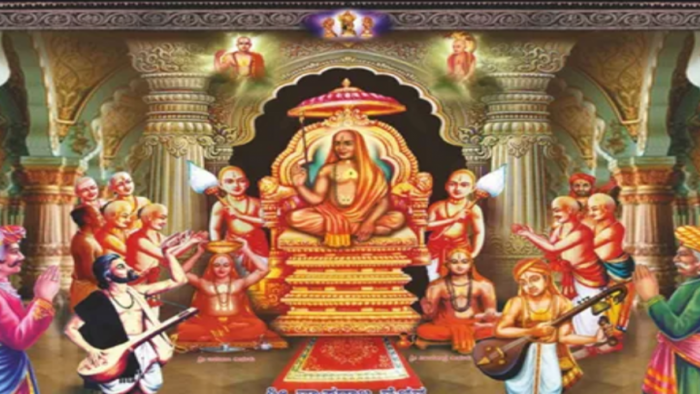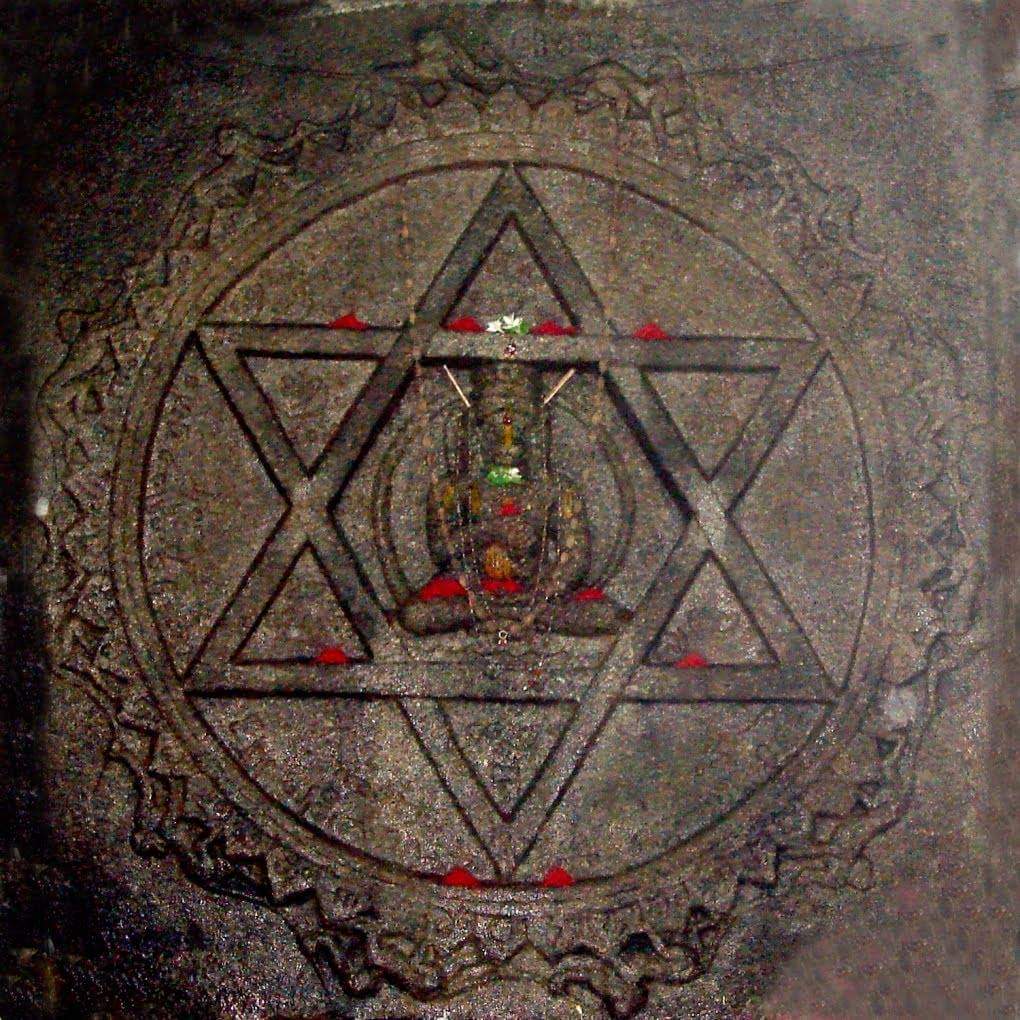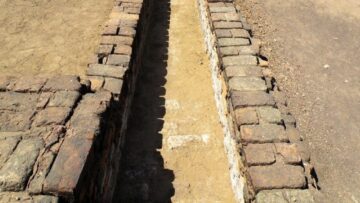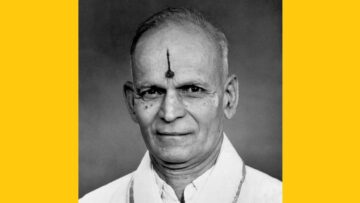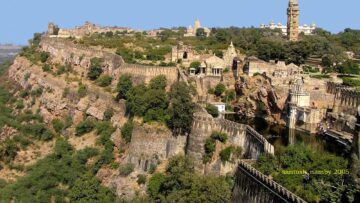It is troubling, even tragic that many Indians are unaware of the huge contribution of Shri Vyasaraya to the rich intellectual and cultural traditions of the land. Acclaimed for being almost unrivalled in the whole field of Indian thought, the Guru’s influence has touched many domains.
A week ago, many people woke up to the shocking news that the Brundavana of Guru Vyasaraja (also called Vyasatirtha and Vyasaraya) has been destroyed and desecrated. The religious site called the Nava Brundavana, which has the Brundavanas of nine seers of the Madhva Sampradaya is located on an island in the Tunghabhadra River in the historic town of Anegundi near Hampi. The Brundavana was rebuilt within 32 hours by hundreds of devotees in a poignant ceremony.
However, it is troubling, even tragic that many Indians are unaware of the huge contribution of Vyasaraya (1460-1539) to the rich intellectual and cultural traditions of the land. This is the very person about whom the renowned scholar Surendranath Dasgupta wrote: “The “logical skill and depth of acute dialectical thinking shown by Vyasatirtha stands almost unrivalled in the whole field of Indian thought.”
Even if the works of Vyasatirtha had been confined to just the realm of dialectics, it was already enough to be remembered down the ages as the one who, along with Jayatirtha (1365-1388) helped to systematize the Dvaita Sampradaya of Madhvacharya (1238 -1317) into an established school of Vedic thought. But Vyasatirtha’s influence went beyond and extended to classical music, irrigation, revival of Hindu consciousness (especially a love for Hanuman and Krishna), diplomacy and a myriad other domains. Whichever domain he touched, he enhanced. The popular song “Krishna nee begane baaro” was composed by none other than Vyasaraya. In modern times, this song inspired bands like Colonial Cousins to come up with their own version. The Guru inspired his disciples to phenomenal levels of Bhakti suffused with creative excellence and their vast legacies which embraced large geographies are still unfolding today.
The Guru who gave Purandara Dasa and Kanaka Dasa to the world
Purandara Dasa (1484-1564) is hailed for developing a system for teaching classical music through a series of graded lessons which are being followed to this date. It was Vyasatirtha who gave the name Purandara Dasa to Srinivasa Nayaka at the time of deeksha (initiation) into the Madhva sampradaya. Purandara Dasa is also called the Father of Carnatic Music. Both the terms ‘Father’ and ‘Carnatic’ might cause some confusion. The distinction between Hindustani and Carnatic schools of music is a recent one which overlooks the antiquity and common origin of Indian classical music which is at least as old as the Vedas. Purandara Dasa went on to create as many as 475,000 compositions of which only about 700 are available today. Using folk ragas and lyrics with references to daily life, Dasa composed deeply spiritual and moving songs that uplifted common people from the miseries of samsara and continue to do so even today. By simplifying and standardizing the teaching system, Purandara Dasa created a template which promoted the easy transmission of classical music over the centuries. Whether one learns Carnatic music from Chennai or from California, one will go through the same steps of learning and for this one must be grateful to Purandara Dasa. What can be a bigger testimony than the fact that Vyasatirtha himself composed a song on the glory of his Shishya called “Dāsarendare purandara dāsarayya” [If it is Dasa (Servant of God) it is Purandara Dasa].
Another important disciple of Vyasatirtha is Kanaka Dasa (1509-1609) who hailed from the Kuruba (shepherd) jaati and was steeped in bhakti for Krishna. The story goes that the attention showered on Kanaka by his guru made the other students jealous of him. They wondered why a student of lower jaati was being elevated by their Guru. In order to make them understand why, Vyasatirtha gave a task to all the students. On Ekadashi day, he gave one banana to each student and said “Go and eat this banana in a place where no one can observe you.” Accordingly, the students completed the task and reported to their Guru about the isolated places they visited to eat their banana unobserved. Only Kanaka came back with his banana uneaten. “I could not find any place where Bhagwan was not watching me,” he said with utmost simplicity. Vyasatirtha hailed Kanaka for his deep and intuitive awareness of Paramatman and gave a strong message to his disciples that whether low-born or high-born, the true Bhakta was conscious of Bhagwan at every instant. Kanaka Dasa wrote more than 240 songs which have been applauded for their literary excellence and for their hard-hitting messages on jaati discrimination.
The impact of the Haridasas
The entire Haridasa (Servants of Hari) movement which started under the umbrella of the Dvaita tradition in Karnataka and spread all over southern India and travelled to Bengal, Assam and even outside India in the form of “Krishna consciousness” has played a monumental role in elevating people from oppressive or materialistic lives and making them feel connected with Paramatman. The movement extended across the spectrum of social, religious, intellectual, musical and literary spheres. It had a deep influence on Carnatic music, and according to one line of thought, Swami Haridas, the Guru of the famous Tansen of Akbar’s court was a part of the same stream.
MV Krishna Rao postulates that the ground for the Haridasa movement in Karnataka had already been prepared by the Vachanakaras of Veerashaivism, the Alwar and Shaiva saints of Tamil Nadu and Jnanadeva (Jnaneshvara) of Maharashtra. The founder of the Haridasa movement in the Dvaita tradition was the musically gifted Sripadaraya, also called Lakshminarayana Tirtha (1422-1480) who headed the Madhvacharya Matha at Mulabagilu. His disciple Vyasatirtha infused the movement with vigour while his closest disciples Vadiraja, Purandara Dasa and Kanakadasa took it to its destined glory. According to Dr B.N.K. Sharma, Vyasatirtha’s name must be invested with special significance because he gave Purandara Dasa and Kanaka Dasa to India.
Chaitanya Mahaprabhu in Bengal was a contemporary of Vyasatirtha and according to many sources, his Gaudiya Vaishnava movement was influenced by the Madhva Sampradaya especially the comprehensive exposition by Vyasatirtha. Chaitanya is said to have visited the Krishna Temple in Udupi and danced in ecstasy. Srila Prabhupada, the founder of the worldwide ISKCON movement places Chaitanya within the lineage of Madhva gurus even though the philosophies of the Dvaita gurus and Gaudiya-Vaishnavas were quite at variance. Such has been the impact of ISKCON that it touched even the life of Steve Jobs in his days of struggle when he waited for Sundays to walk seven miles to eat “one good meal” at the Hare Krishna temple.
How Dvaita powered its way to the mainstream
Let us now take a closer look at the extraordinary life of Vyasatirtha. Before him, Madhvacharya’s Dvaita teachings were popular mainly in the coastal Karnataka region around Udupi. But, by the 16th century, his school of thought had become a “major intellectual, social and political force throughout South India”. According to Valerie Stoker this was mainly due to Vyasatirtha’s polemics and Vijayanagara’s patronage. Vijayanagara was the grand capital of the most powerful kingdom of the time known as Karnataka Empire (wrongly called as Vijayanagara Empire by latter-day historians). The monarchs kept a lively court where scholars engaged in intellectual tournaments.
India already had a long tradition of structured debate. The famous debates between Adi Shankaracharya and Mandana Mishra, Madhvacharya and Trivikrama Panditacharya, Ramanuja and Yagnamurthy and scores of other debates that pitted scholars of one school of thought against another had been savoured down the ages. After Vyasatirtha completed his education in Kanchipuram and delved deep into the six major schools of thought in Hindu philosophy (Shad Darshana) and absorbed the intricacies of Advaita, Vishishtadvaita and Navya Nyaya he proceeded to Mulabagilu. Under Sripadaraja, the budding master got a thorough grounding into the Dvaita of Madhvacharya and then there was no stopping him.
Saluva Narasimha Deva Raya (1431-1491) was the monarch of the Karnataka Empire when Vyasatirtha made his entry into Chandragiri at the behest of his Guru. Over a period of time, the sage made such a place for himself in the hearts of successive rulers that they began to worship him. In fact, Vyasatirtha was only doing what his Guru Sripadaraja had told him – to stay close to the king and help him to follow Dharma in the manner of yogis of ancient times such as Dattatreya who did not care for worldly pleasures or power but wished to benefit the people of the land by advising the king. Vyasatirtha went on to vanquish many leading scholars of the day in intense debates. He was then entrusted with the honour of worshipping the Vigraha of Srinivasa in Tirupati Hill. After Saluva Narasimha Deva Raya died, Vyasatirtha continued to occupy an exalted position in the court of the Empire when Narasimha Raya II (1491 -1505) became the ruler.
The actual control of the empire was in the hands of Tuluva Narasa Nayaka (of Tuluva family) from 1491 to 1503 even though Narasimha Raya II was the ruler. It was around this time that Vyasatirtha moved to Vijayanagara in Hampi, the new capital of the empire where he spent the rest of his life and was recognized as the “Spiritual Adviser” and “Guardian Saint of the State” in a grand ceremony by Tuluva Narasa Nayaka. This place of honour was not confirmed without a challenge informs Dr B.N.K. Sharma. In his words: “Learned men from various parts of India came to challenge him with a public disputation with them. Led by Basava Bhatta of Kalinga they pinned their challenges (Biruda Patras – text) to the palace pillars. The challenge was promptly accepted and Vyasatirtha met the opposing team of scholars and vanquished it completely after a protracted debate lasting for thirty days.”
Viranarasimha Raya, the son of Tuluva Narasa Nayaka took over the reins of the empire from 1505 to 1509. It was during Viranarasimha’s time that Vyasatirtha composed his most defining works – the Nyayamruta, Tatparya Chandrika and Taraka Tandava. Such was Vyasatirtha’s brilliance in laying out the arguments of opposing Vedanta schools before he demolished them with his own reasoning that his works were used by rival schools to understand their own philosophies better. He had plenty of admirers even outside his sampradaya primarily because he taught students in the various educational institutions he established. It is interesting that poet Somanatha, who wrote Vyasayogicharita, the most authoritative biography of Vyasateertha was himself an Advaitin and probably his student.
Valerie Stoker writes in “Polemics and Patronage in the City of Victory”: “That Vyāsatīrtha’s criticisms of these rival Vedānta systems proved to be incisive is evident in the fact that, for the duration of the sixteenth century (and even into the seventeenth), both direct and indirect responses to his works were being composed. This was true not only in South India but as far north as Varanasi, where the Advaitin intellectual Madhusūdana Sarasvatī (fl. 1550) composed a line-by-line refutation of one of Vyāsatīrtha’s most polemical texts, the Nyāyāmṛta.”
Dr B.N.K. Sharma credits Madhusudana Sarasvati for ushering in neo-Advaita in the traditional set-up. According to Dr Stoker, the fact that Vyāsatīrtha’s polemics elicited such a protracted and detailed response from his intellectual rivals attests to the cogency of his critique.
When Guru and King ushered in a strong Hindu empire
After the death of Viranarasimha Raya, his stepbrother Krishnadeva Raya (1509-1529) ascended the throne and went on to become the most illustrious ruler of the Karnataka Empire. Portuguese traveler Fernao Nuniz made one reference to Vyasatirtha in his account of Raya’s rule which is amusing in that it shows how a European perceived a sanyasi: “The King of Bisnaga, everyday, hears the preaching of a learned Brahmin who never married nor touched a woman.”
With Vyasatirtha as his adored Kula Guru, Krishnadeva Raya went on to not only lead the most successful and crushing military campaigns against the Sultans of the Deccan and other kingdoms but ushered in one of the most glorious periods of art, architecture, literature and education in southern India. The ruins of the temples at Hampi evoke awe and admiration even to this day. Almost the whole of southern India including today’s states of Karnataka, Andhra Pradesh, Telangana, Tamil Nadu and Kerala was welded into one empire. Telugu, Kannada, Sanskrit and Tamil were all court languages and extensive literature was produced in them. This Hindu empire stood like a bulwark against the Islamic forces of iconoclasm and proselytization which were ravaging northern India. However, one wonders why an alliance with the Hindu rulers of adjoining Kalinga (present day Odisha) could not be formed and expensive wars had to be fought with them. Be it as it may, the Raya took utmost inspiration from his Guru before tearing into enemy forces in battle and celebrated his victories with grand gestures of gratitude to deities of the land as well as to the Guru himself.
Historians refer to a time during Krishnadeva Raya’s rule when the planetary positions were noted to be aligned against the ruler in a phenomenon called Kuhu Yoga which put him in great danger. To save the king from malafide elements, Vyasaraya sat on the throne himself for a short period and was hailed as Vyasaraja. This has been described in a song composed by Purandara Dasa and the scene of the Guru holding court is still enacted at the Vyasaraya Matha in Karnataka.
Vaishnava sects became more prominent during the time that Vyasaraja held sway in the empire, however the Shaiva and other sects were never neglected. Even though the Guru would not spare a debater from Shaiva or other sects, he was pluralistic in his worldview and is even known to have composed a Shiva stotra and to be particular about worshipping the Shiva Linga presented to him by Basava Bhatta of Kalinga (who had been defeated in debate). The tradition of worshipping the Linga on Mahashivaratri is being followed in Vyasaraya Matha even to this day. From the various acts of respect shown by Krishnadeva Raya to temples of different denominations, it is clear that his Kula Guru was certainly with him in his pluralism. Land grants were given by Raya to temples in Tirupati, Ahobilam, Tiruvannamalai, Amaravati, Chidambaram, and Srisailam.
Once, the king of Kalinga sent a polemical text from the pandits of his court challenging Vyasatirtha. Krishnadeva Raya is said to have got so incensed over it that he ran to his Guru with the document. Vyasaraya was unperturbed and logically pointed out the flaws in the arguments. This delighted the king so much that he performed a Ratnabhisheka to the sage in sheer reverence. Typically an abhisheka is performed with milk, ghee and such materials. But in this case, the king wanted to shower nothing less than jewels on his Guru.
Apart from being guide and preceptor to the king, Vyasaraja also seems to have played the role of a diplomat since many visiting dignitaries such as the Portuguese would go to meet him with gifts. The honour of a green flag on a camel was given to him by the Sultan of Bijapur which is still kept in the Vyasaraya Matha at Sosale. Biographer Somanatha notes that the Guru would receive gifts gracefully from the Raya as well as from visitors but being an ascetic would keep nothing for himself but give them all away to whoever he considered deserving. It is interesting to note a description of the Guru giving away jewels to rulers who came from different regions – bracelets to those from Kerala and Konkan, pearls to the Persians, crowns to the Latas, rings to those from Kalinga, gold coins to Turks, crest jewels to the Gaudas, rubies to the Cholas, jeweled girdles to the Panchalas and so on.
After Krishnadeva Raya’s death (1530), the next ruler Achyuta Deva Raya continued to honour Vyasatirtha. It was in Achyuta’s reign that the Guru consecrated an image of Yogavarada Narasimha in the courtyard of the Vithalaswami temple in Hampi in 1532. When Vyasatirtha finally left his body, his mortal remains were installed in a Brindavana covered with artistic carvings including the symbol of the royal elephant on the instructions of Achyuta Raya. It is believed that Shri Raghavendra Tirtha (1595-1671), another charismatic and well-loved Guru of the Madhva Sampradaya who also engaged in famous debates and wrote commentaries was none other than a reincarnation of Vyasatirtha.
The Educational Heritage of the Karnataka Empire
Vyasaraya received large tracts of land as grants from Krishnadeva Raya which he used for constructing mathas and agraharas that became great centres of education. It was a common practice among Hindu kings to give land to great scholars in order that they could establish centres of learning. In fact, this practice was central to the vast ecosystem of learning that nurtured famous universities and thought leaders in India. Earlier in the fourth century, Mayuravarma, a famous king from the Kadamba dynasty had given huge tracts of land to Brahmin scholars from northern India who were well-versed in various disciplines for a similar purpose. According to Venkoba Rao’s commentary on Somanatha’s Shri Vyasayogi Charitam: “Now there is no doubt that he [Vyasaraya] was the Chancellor of the Imperial University of the Vijayanagar Empire…Students flocked to this University of Vijayanagar from all parts of India.” It must have been quite an experience for students to listen to a celebrated professor teaching his own works. Somanatha has described poetically that when Vyasaraya himself taught Nyayamrita it seemed as if Vishnu was distributing the amrita (nectar) that came out of the ocean of learning.
Dr M.V. Krishna Rao explains in “Purandara and the Haridasa Movement” that when parents wanted to give their children a sound and liberal education, they sent them to the nearest matha and that Vyasaraya’s matha was much sought after. He explains that mathas taught a variety of subjects – Kavya, Nataka, Alankara, Vedanga, Bhugola, Lilavati and others.
Vyasaraya patronized large-scale irrigation projects in the barren lands he received in order to produce a bounteous harvest of crops which could be used to worship deities in temples and then distributed to people as prasada. Economic opportunities were created for artisans and a variety of other professions which also helped in political integration. Thus, the land grants were used to benefit the general population both directly and indirectly. Many times, Krishnadeva Raya gave land to Vyasatirtha in the very areas where he quelled rebellions perhaps knowing well that the Guru’s establishment of mathas and irrigation projects would bring education, economic prosperity and loyalty for the empire.
The tradition of Hanuman worship
Today, we are not surprised to find temples dedicated to Hanuman scattered all over India. From what we see in various records, it was not always like this. Even though Hanuman is a very important character in the Ramayana and is extolled for his virtues, the temples being built and patronized by all sections of society until the 15th century were mostly for the myriad forms of Shiva, Vishnu, Durga, Lakshmi and other major deities.
According to many, it was Goswami Tulsidas (1532 -1623) who made Hanuman very popular with his Ramcharitmanas and Hanuman Chalisa. While the role of these two outstanding works in magnifying the popularity of Hanuman in northern India cannot be denied, the truth is that long before Tulsidas, there was Madhvacharya (1238-1317) who gave an extraordinary place of honour to Vayu and his avatars Hanuman and Bhima.
The tradition of honoring Hanuman (and Bhima) as a symbol of strength, protection and wisdom started by Madhvacharya was taken to great lengths by none other than Vyasatirtha in the 15th century who consecrated as many as 732 temples to Hanuman! These temples were scattered over today’s Karnataka, Andhra Pradesh, Telangana and Tamil Nadu. Until the year 2012, about 525 Hanuman vigrahas have been traced mainly due to the private efforts of Shri Gowdagere Vijaya Kumar Acharya who travelled more than 45,000 km on a quest for the temples. The most famous is the Yantrodharaka Hanuman temple in Hampi.
The distinctive depiction of Hanuman in the temples is that of Veera Hanuman as opposed to the Ramabhakta Hanuman; in other words the fierce aspect of the God who is needed to protect the land. There are special features which devotees use to identify the Anjaneya (Hanuman) motif consecrated by Vyasaraya such as the tail which goes around the head and has a bell at the end. Some 150 years later, Samarth Ramdas (1608 -1681) of Maharasthra established Hanuman temples all over India with the intention of instilling fearlessness and emphasizing on physical fitness in order to fight the Islamic forces which had devastated the Hindu psyche.
Conclusion
A few decades after Vyasatirtha left, all the Sultans of the bordering states united in 1565 in order to destroy the Karnataka Empire and inflicted horrific damage to its beautiful temples in Hampi which can be witnessed even today. But, if one wonders why more than 800 years of Islamic rule and nearly 200 years of British Raj could not succeed in wiping out Sanatana Dharma from Bharata, then one must examine the work of the Gurus of the land.
In most parts of the world, there is little trace left today of the ancient pre-Islamic and pre-Christian faiths that were once followed by people. Yet, Hindus continue to derive strength from the very deities whose temples were destroyed again and again. They pursue degrees from the best universities in an almost pre-programmed manner. They lecture and confer, debate and deliberate without any idea about the continuity with the past. It is time to find the golden thread that connects Hindus back to the Gurus who gave them such a unique civilization.
The author would like to thank Sunil Vasisht for his invaluable guidance and inspiration. She would also like to acknowledge Vishal Agarwal for offering crucial help with references.
Bibliography
Sharma BNK. The History of the Dvaita School of Vedanta and its literature. Motilal Banarasidass. 2000.
Rao, Venkoba. Śrī Vyāsayogicaritam: Life of Śrī Vyāsarāja, a Champū Kāvya in Sanskrit by Somanātha. Bangalore: Dvaita Vedanta Studies and Research Foundation. 1926
Krishna Rao M.V. Purandara and the Haridasa Movement
Rao V. Living Traditions in Contemporary Contexts: The Madhva Matha of Udupi. Orient Longman. 2002.
Dasgupta S, A History of Indian Philosophy Vol IV, The Syndics of the Cambridge University Press. 1949.
Stoker V. Polemics and Patronage in the City of Victory. The University of California Press. 2016
Ramanujan S.R. Vijayanagara: The Never to be Forgotten Empire, Notion Press. 2019
Disclaimer: The opinions expressed in this article belong to the author. Indic Today is neither responsible nor liable for the accuracy, completeness, suitability, or validity of any information in the article.

